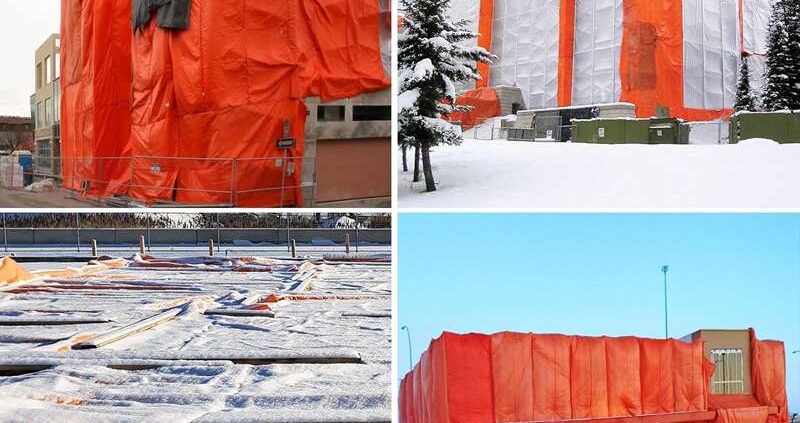Which is better: PVC Insulated Tarps or PE Insulated Tarps?
Comparison: PVC vs PE for Insulated Tarps
Key Material Differences
PVC (Polyvinyl Chloride): A heavier,coated fabric often used for long-term, heavy-duty covering. It offers stronger weather resistance, chemical resistance,UV resistance and durability.
PE (Polyethylene): A lighter film/laminate or woven sheet. More cost-effective, more flexible (in some usage) but tends to have lower durability, weaker UV/aging resistance, and may be less appropriate for long-term exposure.
How these differences affect insulated tarp performance?
- Durability / lifespan: PVC tarps last significantly longer in harsh environments (UV, cold, wind) than PE tarps.
- UV & weather resistance: PVC typically resists UV degradation, aging and extreme temperature better than PE.
- Flexibility / weight / cost: PE is lighter and often cheaper; if you need a short-term solution or lighter handling, PE might be attractive.
- Insulation / thermal control: While both materials can be used as outer covers for insulated tarps, the better outer material (resistance to weather, longer integrity) helps maintain the insulation’s performance.
- Maintenance & reuse: Because PVC is more robust, it is better for reuse across seasons; PE may degrade faster, reducing lifespan and total cost efficiency
Which is better for insulated tarps?
If your insulated tarp will be used for long-term outdoor exposure, repeated use, harsh weather, or industrial applications, PVC is typically the better choice.
If your application is temporary, budget-sensitive, or inside more controlled conditions (less UV / less harsh environment), then PE may suffice.
| Category | PVC Insulated Tarps | PE Insulated Tarps | Recommendation / Remarks |
|---|---|---|---|
| Material Composition | PVC-coated polyester fabric with internal insulation (foam, bubble, or fiber layer) | PE laminated woven fabric with insulation padding | PVC has a stronger, denser structure — ideal for heavy-duty use |
| Surface Texture | Smooth, glossy, and fully coated (non-porous) | Slightly textured woven surface (micro-porous) | PVC’s smooth surface improves water and gas resistance |
| Weight Range | 550–850 gsm | 180–350 gsm | PE is lighter; PVC offers superior stability |
| Thickness Range | 0.45–0.85 mm | 0.20–0.35 mm | Thicker PVC provides better insulation and wind resistance |
| Waterproof Rating | ≥ 10,000 mm H₂O | ≥ 5,000 mm H₂O | Both waterproof; PVC is more reliable under pressure |
| Temperature Range | −40°C to +80°C | −20°C to +60°C | PVC maintains flexibility in extreme cold |
| UV Resistance | Excellent (≥ 800 hours ASTM G154) | Moderate (200–300 hours ASTM G154) | PVC lasts 3× longer under sunlight |
| Tear Strength | Warp ≥ 300 N / Weft ≥ 250 N | Warp ≥ 120 N / Weft ≥ 100 N | PVC offers superior mechanical strength |
| Insulation Efficiency | 15–25% higher heat retention due to dense coating and tight seams | Suitable for mild insulation tasks | PVC retains heat longer during cold-weather curing or storage |
| Fire Retardancy | Optional FR-grade available (NFPA 701, B1/B2) | Rarely fire-retardant | PVC can be upgraded for safety compliance |
| Reusability | 3–5 years lifespan; supports multiple seasonal cycles | 1–2 years; tends to degrade faster | PVC offers better long-term ROI |
| Maintenance | Easy to clean and re-weld if damaged | Can tear easily; difficult to repair | PVC preferred for repeated industrial applications |
| Environmental Impact | Recyclable PVC available (RoHS/REACH compliant) | Eco-friendly PE but shorter lifespan increases waste | Choose PVC for durability; PE for short-term eco projects |
| Typical Applications | Concrete curing, industrial insulation, outdoor storage, cold-climate protection | Short-term covering, agriculture, mild-temperature protection | PVC suits heavy-duty, PE fits temporary or budget-sensitive needs |
| Cost Level | Moderate to high (premium quality) | Low to moderate (economical) | PVC costs more initially but lasts 2–3× longer |
| Overall Performance | ⭐⭐⭐⭐⭐ Heavy-duty, long-term, professional-grade | ⭐⭐⭐ Good for light-duty or temporary use | PVC is the industry standard for industrial and cold-weather projects |
How to choose the difference Insulated Tarps?
Choose PVC Insulated Tarps when you require:
- Maximum durability and lifespan
- Strong UV / weather resistance
- Heavy duty use with repeated installations
- Better return-on-investment over tim
Choose PE Insulated Tarps when you require:
- Lower upfront cost
- Lighter weight / easier handling
- Short-term usage or controlled environment
| Application Type | Best Choice | Reason |
|---|---|---|
| Concrete curing in cold weather | PVC Insulated Tarp | Strong heat retention and tear strength |
| Outdoor storage (equipment, containers, IBCs) | PVC Insulated Tarp | Superior UV and weather protection |
| Short-term agricultural use | PE Insulated Tarp | Lightweight and affordable |
| Frequent reuse or export packing | PVC Insulated Tarp | Reusable and durable |
| Budget-limited, one-time cover | PE Insulated Tarp | Low-cost solution for temporary use |



